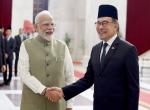A recent incident in Kolkota has set alarm bells ringing. A rowdy crowd from the ruling Trinamul Congress in West Bengal blocked a public street during some celebrations. This led to clashes with workers of the opposition and the police intervened, cleared the street and arrested two persons who happened to be senior workers of the ruling party. The Chief Minister of West Bengal, Mamata Banerjee, personally went to the police station, publicly insulted the Police Commissioner and senior officers, humiliated the Station Officer of the police station and forced the police to release the two arrested persons. Quite apart from demoralising the police the action of the Chief Minister in forcing the release of the two arrested persons was an act of goondaism and totally contrary to law. We accuse the police quite often of being highhanded and taking the law into its hands. Why is there not similar criticism of the action of the Chief Minister of West Bengal?
The police was organised as a disciplined force having legal powers to maintain public order, prevent the commission of offences, investigate crimes and prosecute criminals and for this purpose the British enacted the Police Act of 1861. Prakash Singh, who served as DGP U.P and DGP C.R.P. filed a Public Interest Litigation in which he has alleged that the Police Act of 1861 is excessively restrictive and subjects police officers to outside control, thus adversely affecting their autonomy and their efficiency as a Force for law enforcement. The Supreme Court has directed that the police must be reformed so that it begins to act as an agency for law enforcement and does not degenerate into a handmaiden of politicians and bureaucrats. Government set up the Soli Sorabjee Committee for suggesting the draft of a new Police Act, which committee submitted its report to government in October 2006. Let us begin with the Act of 1861. Section 3 of the Act vests superintendence of the police in the State Government. Certain words of section 3 need to be reiterated because they are of vital importance in ensuring that the police functions according to law. These words are, “ … except as authorised under the provisions of this Act, no person, officer or court shall be empowered by the State Government to supersede or control any police functionary”. No member of the Legislature, no bureaucrat unless authorised by the Act or the Code of Criminal Procedure and no court has any control over any police functionary, which establishes the fact that so long as the police functions according to the law it is free to act without let or hindrance.
Section 4 of the Act vests the administration of the police throughout the State in the Inspector General of Police (Now Director General of Police), just as the administration of the police in a district vests in the Superintendent of Police. The District Magistrate does have general control and direction, but this is only in consonance with the fact that he is the chief coordinating officer in the district and direction and control would be exercised only in a coordinating role. There is nothing in this Act which subordinates the police to any other authority and no other legal reform can really give more strength to the police than is available to it under the 1861 Act. Unfortunately neither the police officers calling for reforms nor the Supreme Court have tried to understand the spirit of the Act of 1861. The sole attack on this Act is that it is a carry over from British rule. By that argument the Constitution of India should be scrapped because it is also substantially a carry over from the Government of India Act 1935.
The police derive powers not from the Police Act, which is aimed at providing an organisation for and structure of the police, but from the Code of Criminal Procedure and various other laws dealing with criminal justice. Broadly speaking, Chapter XI Cr.P.C authorises the police to take preventive action so that cognizable offences may be prevented. For this purpose the police have the powers under section 151 to arrest a person to prevent the commission of a cognizable offence and under section 152 the police has the power to intervene in order to prevent injury to public property. Under Chapter VIII Cr.P.C on police initiative an Executive Magistrate has the power to bind over persons to prevent a breach of peace, to ensure good behaviour from persons disseminating seditious matters, to bind over persons suspected to be contemplating the commission of a cognizable offence and bind over habitual offenders. Under Chapter V the police have the power to make arrest under sections 41 and 42 and under section 47 the police can search a place entered by a person liable to be arrested. Under Chapter VII the police can issue summons to produce documents or other material necessary for the purpose of an investigation and, on a warrant, to conduct a search of any premises for letters and telegrams, stolen property, forged documents, prohibited publications and to search premises for persons wrongfully confined or females abducted.
In the matter of offences the principle powers of the police are derived from Chapter XII Cr.P.C. In fact all the investigations begin with the filing of a First Information Report in a cognizable offence under section 154 Cr.P.C. Under section 156 the police have the power to investigate any cognizable offence and other sections from 157 to 173 give the procedure for investigation, prosecution or closure of a case. The procedure laid down is quite comprehensive and it is only the police which have the power to investigate. No other authority, not even a court, may intervene in investigation. The only authority which may give any direction to an investigating officer is a superior officer of police designated by the State Government by general or special order under section 158 Cr.P.C. Certainly no executive officer or politician has any authority whatsoever to interfere with investigation. The autonomy of the police in the matter of investigation, therefore, is absolute and once the FIR is recorded it is only a competent court with which the investigating officer will interact, either directly or through a superior officer under section 158 Cr.P.C. Mamata Banerjee’s intervention in a police station in Kolkota, therefore, was totally illegal and is an offence under sections 353 and 186 IPC. She both assaulted a public servant and obstructed him in discharge of public functions and regardless of the fact that she is Chief Minister she should have been booked for these offences. The day a police officer does this when some person of influence tries to interfere in the investigation of an offence, the police will truly become a servant of the law.
Chapter X Cr.P.C. provides for maintenance of public order and tranquility. This is a function which devolves on the Executive Magistracy and the police. Where an Executive Magistrate feels that civil force is inadequate to deal with the situation he may use the armed force to restore order. Under section 129 Cr.P.C an Executive Magistrate, an officer in charge of a police station or any police officer not below the rank of Sub Inspector may command an unlawful assembly to disperse and use necessary force to enforce his order. This force could extend to using lethal force if the situation so demands. Under section 132 Cr.P.C the officer who took the action is immune from prosecution. The decision whether an assembly of five or more persons is unlawful because either there is a prohibitory order in force or, in the opinion of the officer concerned, it is likely to cause a disturbance of public peace, lies within the discretion of the officer on the spot and unless the action which follows is palpably wrong and excessive the officer cannot be questioned for his decision. Nowhere does the Code of Criminal Procedure say that any other person, a Minister, a politician, a bureaucrat or a member of the general citizenry can interfere with the action of the Executive Magistrate or the police officer in the matter of restoration of public order.
When the Communists took power in West Bengal they ordered the police not to interfere in any labour unrest in which criminal force was used to prevent the ingress or egress of management officials in any industrial or business establishment. This is commonly called gherao. Every gherao amounts to wrongful restraint and confinement. These are cognizable offences and anyone committing these offences automatically becomes part of an unlawful assembly. Under the power of superintendence the State Government can give instructions to the police on the manner in which force is to be used when dealing with an unlawful assembly. For example, it would be lawful for government to direct the police that when dealing with a communal riot or major insurrection it must not hesitate to use force and must ensure that public order is restored in the shortest possible time so that lives can be saved. When dealing with industrial unrest, a student agitation or agitation over some social evil in which women and children participate it would be legitimate for government to direct that the police will exercise utmost restraint. What government cannot do is to tell the police to ignore cognizable offences such as obstructing a public street or wrongfully confining people in the name of a public agitation. In the maintenance of public order the law gives the police and the Executive Magistrate complete independence, subject to directions given under the power of superintendence. It is wrong on the part of government to try and intervene in such matters and tell the police to act with bias or otherwise behave one-sidedly in the maintenance of public order or, for that matter, not act at all. That power just does not vest in government.
The existing law gives a great deal of operational autonomy to the police. The allegation is that political interference takes the form of postings and transfers, denial of promotions and other forms of discrimination against police officers doing their duty. The National Police Commission under the chairmanship of Shri Dharma Vira was set up to find ways and means of stopping such undue interference and immunising the police from outside influence. The thrust of the Commission’s report was three-fold:
- Set up National and State Security Commissions which would lay down the guidelines and generally prevent government form interfering in police work
- Loosen the hold of the District Magistrate.
- Ensure security of tenure to police officers.
The report of the Commission was never implemented for two main reasons:-
(a) The politicians looked upon the so-called Security Commission as a rival which they were not prepared to accept.
(b) Secondly, they were not prepared to loosen their hold over police postings and transfers.
Regarding the District Magistrate, even the Commission ultimately recognised that we need a coordinating officer in a district and the D.M is not in any way responsible for the present sorry state of the police. The Supreme Court, in the PIL filed by Prakash Singh, has basically reinforced what the National Police Commission said, but has gone further by stating that there should be separate authorities for police accountability. It is not as if there is a shortage of authorities which can question the police. The National and State Human Rights Commissions, Women’s Commissions, Child Rights Protection Commissions, Minority Commissions, etc., are all agencies which can call the police to account. The role of the District Magistrate as a coordinating officer is important because he is the one agency whom the common man could approach for redressal of grievances and, because of his close relationship with the Superintendent of Police, he could get most of these grievances settled at the district police level. He could be supportive of the police when necessary and yet persuade the Superintendent of Police to take necessary corrective action when this was called for. Replacing his authority by a State Police Complaints Commission or the District Complaints Authority will not improve the system but will in fact add further confusion to it. What the Supreme Court has not appreciated is that the chain of command has to be clear and the local level grievance redressal machinery has to be simple but effective. The proposed police reforms will not achieve this.
Of course the police should have legal protection, there should be a tenure and the head of the police should be the one to decide who is best suited to serve where. Government’s true role should be to prepare a plan of policing, give specific directions to the head of the police about what is expected of him and his Force and then to call him to account from time to time. Action must follow if there is failure on the part of the police. This action has to be based on an objective assessment of police performance. The head of the police must insist that his authority in the matter of administration of the police must not in any way be diluted and he must stand up to government if he finds that there is undue interference. The Secretary in charge of the Home Department in every State must not only liaise closely with the D.G. Police but must also be supportive of his actions. It is the responsibility of the Chief Minister to ensure that his Ministers and party workers do not intervene in the operational autonomy of the police. The police is accountable to the Home Minister but the Home Minister is not empowered to intervene in day-to-day policing. This is the ideal position in which the police can become truly an instrument of the law.
One thing which causes anxiety is that in any large-scale breakdown of law and order, whether it is militancy, Naxalite terror, external injection of terrorism, communal rioting or otherwise widespread unrest, the police is extremely hesitant in taking action. Therefore, the State Police cannot be trusted and Central Police Forces are brought in. No Central Police Force can ever be a real substitute for the State Police because it does not know the local terrain and the people and, therefore, it is likely to arouse hostility in the local people. A good, effective State Police does know how to handle local people and the local situation and our efforts should be aimed at making the State Police efficient, well-equipped, knowledgeable and with adequate operational freedom to maintain public order. Our experience of the Punjab is that it is only when K.P.S. Gill forged the Punjab Police into an efficient anti terrorism weapon that militancy came under control in that State. A recent study of Naxalite hit districts in Bastar Division of Chhattisgarh by the National Centre for Human Settlements and Environment indicated that the State Police was more effective and more readily acceptable by the people in any anti-Naxalite operation than the Central Reserve Police. These two examples prove the point that whereas the Central Armed Police Forces can provide back up where needed, it is the State Police which has to be in the forefront of crime control. Terrorism is also a crime. Just think what a difference it would have made in Mumbai if the Colaba Police Station had been adequately equipped and manned so that it could intercept the ten terrorists from Pakistan who landed on the Colaba sea front and wreaked havoc in the city for three whole days. Had the Colaba Police been able to intercept these terrorists they would have been neutralised on landing and the horrors of 26.11.2008 could have been totally avoided. For the inadequacy and the inefficiency of the Maharashtra Police as represented by a single police station we lost almost two hundred people dead. This must never happen and for this purpose the nation must empower the police, adequately equip it in both equipment and manpower, give it room to operate freely, call it to account from time to time, punish failure but equally importantly reward good work. The least that citizens deserve is a good police force.
------------------------------------------------
Published Date : 23rd November 2011









Post new comment